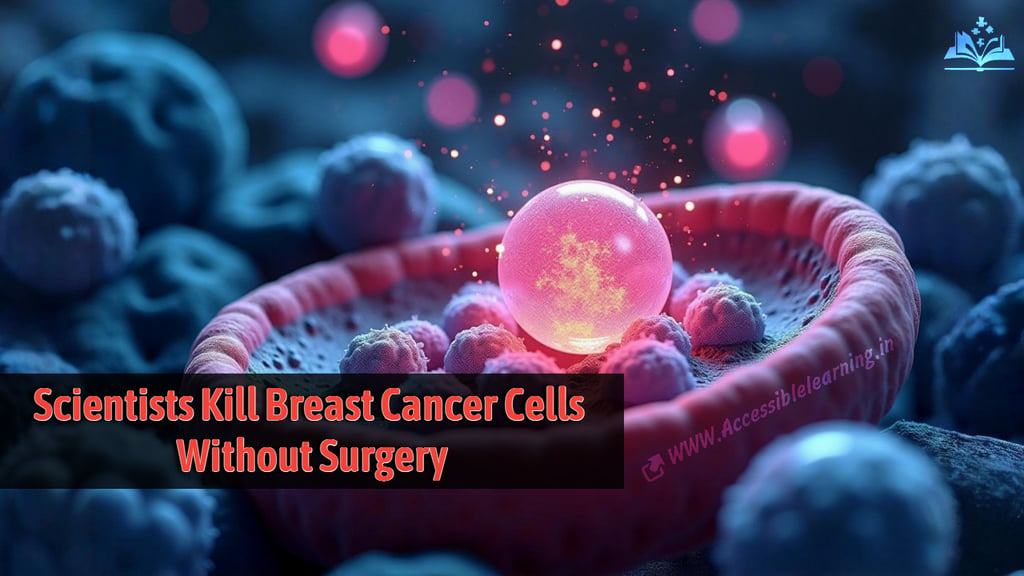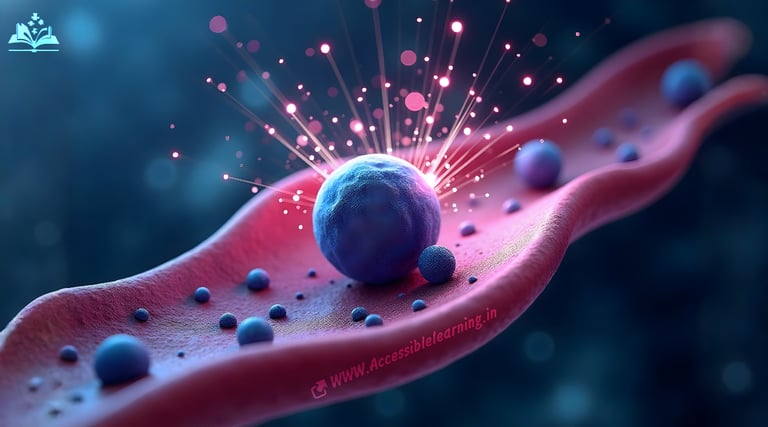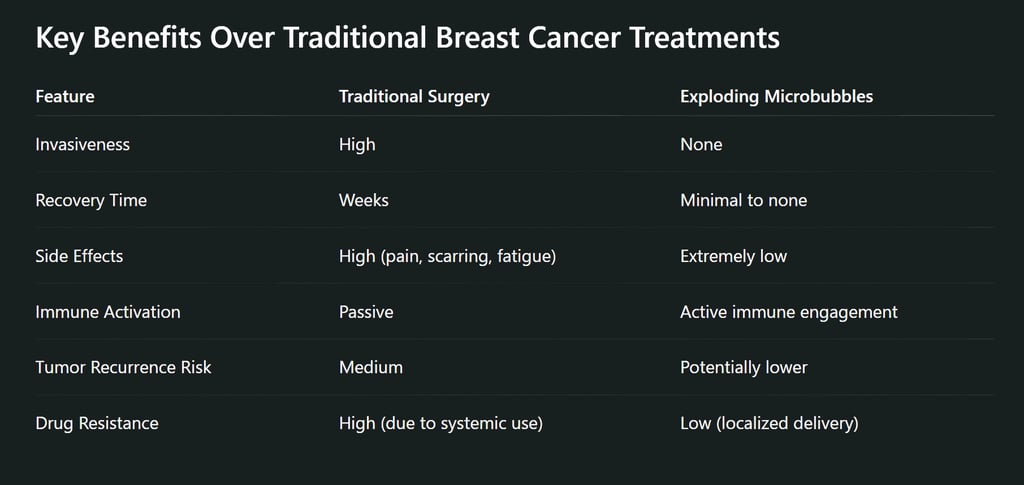
Scientists Develop Exploding Microbubbles Activated by Ultrasound to Kill Breast Cancer Cells Without Surgery
Discover how scientists are using ultrasound-activated exploding microbubbles to kill breast cancer cells without surgery. A revolutionary, non-invasive cancer therapy with targeted precision, immune activation, and minimal side effects.
MODERN DISEASESHEALTH/DISEASESPACE/TECHEDUCATION/KNOWLEDGE
Kim Shin
5/22/20254 min read


In a landmark step forward for non-invasive cancer care, scientists have created a pioneering technique using exploding microbubbles activated by ultrasound to precisely target and kill breast cancer cells without surgery, radiation, or chemotherapy. This futuristic approach—still in experimental stages—could soon be one of the safest and most efficient methods of treating cancer.
With rising global breast cancer rates and increasing demand for less invasive therapies, this innovation marks a potential paradigm shift in how we combat one of the world’s deadliest diseases.
What Exactly Are Exploding Microbubbles?
These are tiny gas-filled spheres, typically made of lipids, polymers, or proteins, measuring between 10 micrometers. Originally designed as contrast agents for ultrasound imaging, microbubbles are now being weaponized in cancer therapy through a process known as theranostics—a blend of therapy and diagnostics.
Once introduced into the bloodstream, these microbubbles latch onto cancer cells via ligands—molecules that can bind specifically to cancer-associated receptors like HER2 or EGFR, which are common in aggressive breast cancers.
When an external high-frequency ultrasound is applied, the microbubbles oscillate and collapse violently—a process called inertial cavitation—generating localized shockwaves, microjets, and mechanical stress that shred cancer cells open without harming the surrounding tissue.
What’s New: Advanced Functionalization and Smart Targeting
What makes recent research even more remarkable is how customized and intelligent these microbubbles have become. Scientists are now
Functionalizing Microbubbles with Antibodies
By attaching monoclonal antibodies (like trastuzumab) directly onto the microbubble surface, researchers can target HER2-positive breast cancer cells with extreme precision.
Combining With Nanoparticles
Some labs are embedding gold nanoparticles or magnetic iron oxide particles inside the bubbles to enhance both targeting and energy transfer, enabling dual-modality imaging (MRI and ultrasound) and improved mechanical lethality during burst.
Engineering Drug-Loaded Microbubbles
Newer models carry chemotherapeutic drugs or gene-silencing agents (siRNA, CRISPR), releasing them precisely at the tumor site when the bubble pops—reducing systemic toxicity and boosting treatment impact.
How It Works: Step-by-Step Process of Tumor Destruction
Targeted Delivery: Microbubbles are injected intravenously. They travel through the bloodstream, find the tumor via bioengineered homing molecules, and accumulate at the cancer site.
Focused Ultrasound Activation: A non-invasive, externally applied ultrasound beam targets the tumor. The operator controls the depth, frequency, and focus to limit impact only to the tumor.
Explosion and Cellular Disruption: On impact, the bubbles burst with high energy, causing:
Mechanical rupture of cell membranes
Intracellular calcium overload
Endothelial damage to tumor blood vessels
Activation of apoptotic (programmed cell death) pathways
Immune System Boosting: The cancer cell debris acts as an immune stimulant, possibly triggering a secondary immune response—turning this into a potential immunotherapy enhancer.

Exciting Potential: Turning the Body Into Its Own Cancer Fighter
One of the most exciting dimensions of this technology is its ability to “immunologically prime” the tumor microenvironment. When cancer cells are burst open by cavitation, they release danger signals (DAMPs) and tumor antigens that can trigger dendritic cells and cytotoxic T-cells.
This essentially recruits the immune system to join the battle—something that could be synergistic with checkpoint inhibitors and other cancer immunotherapies.
Imagine a world where exploding microbubbles not only destroy tumors but also vaccinate your body against cancer recurrence.
Promising Results: What the Studies Reveal
Recent experimental data from preclinical studies on mice and organoid models show:
90–95% tumor cell death within 48 hours after treatment
No adverse impact on healthy adjacent tissue
Enhanced delivery of drugs like paclitaxel and doxorubicin when co-loaded with microbubbles
Dramatic reduction in metastatic spread when used in early-stage models
Additionally, live imaging studies show real-time tumor shrinkage using microbubbles, offering clinicians the power to monitor therapy on the spot.
A Glimpse Into the Future: What's Coming Next?
While human clinical trials are on the horizon, here are some exciting research extensions already underway:
Artificial Intelligence Integration
AI models are being used to predict optimal bubble dosage, ultrasound frequency, and patient-specific targeting—personalizing therapy in real time.
Wireless & Portable Ultrasound Devices
Imagine at-home or outpatient cancer therapy powered by wearable or handheld ultrasound devices, working in tandem with precision-injected microbubbles.
Cross-Cancer Application
Beyond breast cancer, this technology is being adapted for:
Brain tumors (with blood-brain barrier disruption)
Pancreatic cancer
Prostate and liver cancers
Glioblastoma, using MR-guided focused ultrasound




The development of exploding microbubbles isn’t just about saving lives—it’s about changing the way we experience cancer. No more long hospital stays, no more harsh chemo infusions, and no more irreversible surgeries. Just science, sound waves, and a new kind of hope.
This technology reflects a fusion of physics, nanotechnology, medicine, and bioengineering, leading us to a future where fighting cancer doesn’t have to mean suffering through it.
As research progresses, the dream of a non-invasive, highly targeted, immune-enhancing, side-effect-free cancer cure is closer than ever before.
FAQs
What are exploding microbubbles & how do they treat breast cancer?
Exploding microbubbles are tiny gas-filled bubbles that, when injected into the body and activated by ultrasound waves, burst near cancer cells. This controlled explosion disrupts the tumor’s structure, damages cancer cells directly, and enhances the body’s immune response — all without the need for invasive surgery.
Is the exploding microbubble technique safe for patients?
Yes, this method is considered safe in early-stage trials. Since it uses non-ionizing ultrasound and localized targeting, it avoids damage to healthy tissues and has minimal side effects compared to chemotherapy or radiation.
Can this therapy completely replace surgery for breast cancer?
Not yet. While promising, exploding microbubble therapy is still under clinical evaluation. It’s currently seen as a complementary or alternative treatment for certain types of tumors, especially small or difficult-to-access ones. Over time, it may become a standalone option in early-stage or inoperable cancers.
How soon could this technology become available for public cancer treatment?
The timeline depends on the results of ongoing clinical trials. If proven effective and safe, it could become available within 5 to 10 years, subject to regulatory approvals and scalability.
Does ultrasound-activated microbubble therapy cause pain or discomfort?
The process is largely painless. Patients may feel a slight warming sensation or pressure, but no cutting or invasive procedures are involved. It’s a non-surgical, outpatient-friendly method.
Can this method treat cancers other than breast cancer?
Yes. Researchers are also exploring its use in liver, pancreatic, brain, and prostate cancers. The technology holds promise across multiple tumor types due to its targeted, non-invasive nature.
Who is developing this technology?
Multiple research institutions and biotech firms worldwide, including teams in Japan, the UK, and the U.S., are leading the development — often in collaboration with oncologists, engineers, and immunologists.
Subscribe To Our Newsletter
All © Copyright reserved by Accessible-Learning Hub
| Terms & Conditions
Knowledge is power. Learn with Us. 📚


